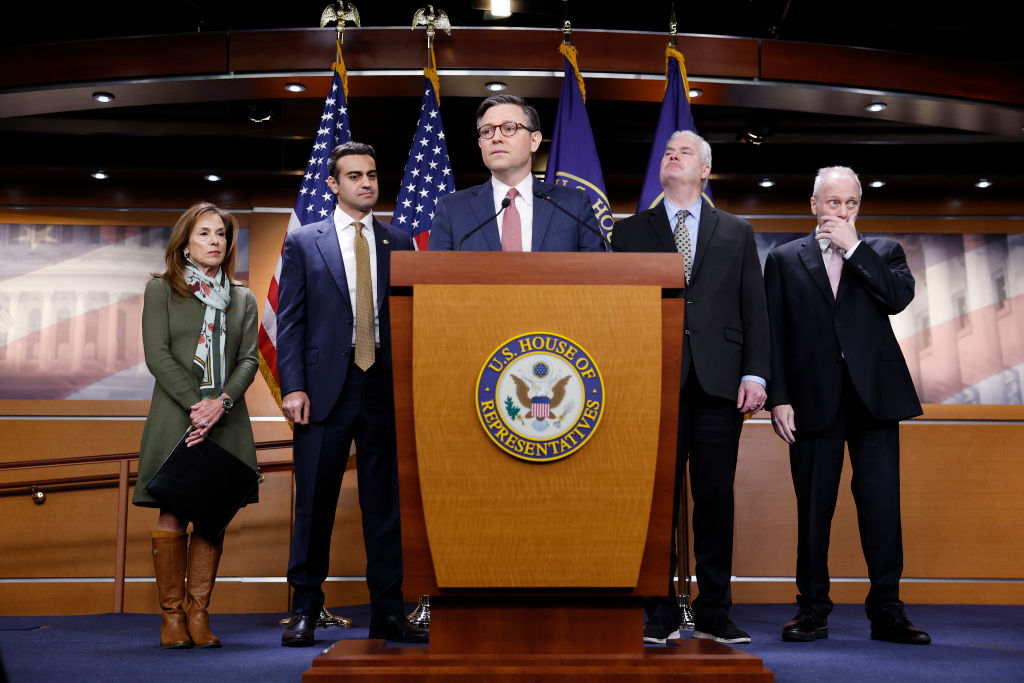After much fanfare, the House GOP majority has released its latest 10-year budget blueprint. Up until now, Elon Musk and his Department of Government Efficiency (DOGE) have controlled Washington’s fiscal narrative with high-profile attempts to cancel government contracts, remove federal employees, and shut down the agency in charge of distributing international aid assistance. While DOGE has trumpeted its (unverified) claims of saving a few billion dollars here and there, the new House budget resolution would likely add $3.3 trillion to 10-year deficits. These costs will dwarf the largely symbolic DOGE budget savings and show a Republican government once again dramatically driving budget deficits upward.
Real tax cuts, gimmicky savings.
The Congressional Budget Office’s latest baseline projections show Washington running $21 trillion in budget deficits over the 2025-2034 period covered in the Republican budget proposal, pushing the federal debt held by the public from $29 trillion to $50 trillion. That rosy scenario assumes no wars, no recessions, low interest rates on the federal debt, and nearly unprecedented limits on discretionary spending.
Against that baseline, the House GOP blueprint claims to save $1.1 trillion over the decade. In reality, it will likely add $3.3 trillion in debt. Specifically, tax cut extensions will cost $4.5 trillion but are offset only partially, with $1.2 trillion in mandatory program savings. The blueprint also includes promises of $2.6 trillion in additional tax revenues based on economic growth and $1.8 trillion in future discretionary spending savings, but those should be classified as gimmicks.
Start with the tax cuts. The House Ways and Means Committee received reconciliation instructions from this legislation to build a package adding $4.5 trillion to 10-year deficits, which should cover the roughly $4 trillion cost of extending the expiring Tax Cuts and Jobs Act. But that may not leave enough room to expand the state and local tax (SALT) deduction or include President Trump’s calls to end taxes on tips and overtime.
The committee could incorporate all these tax relief measures if it is willing to offset them with other tax increases or savings from the spending programs it oversees such as Medicare. It is more likely that Congress will add SALT relief and maybe tax-free tips, while shortening the tax cuts’ time frame from 10 years to perhaps seven years. But shortening the timing window is merely a gimmick given the likelihood that Congress simply renews the tax relief again at the next expiration date, ultimately raising the 10-year cost.
The $1.2 trillion in mandatory spending savings promised over the decade are legitimately presented yet face an uphill battle with a razor-thin House majority. The largest savings would consist of $880 billion over the decade from the Energy and Commerce Committee (almost certainly Medicaid reductions), $330 billion to be cut by the Education and Workforce Committee (most likely from student loans), and $230 billion in savings assigned to the Agriculture Committee (likely from SNAP food assistance). On the flip side, the budget would allow the Armed Services, Judiciary, and Homeland Security committees to collectively add $300 billion in 10-year spending for defense, border security, and likely immigrant deportations.
“Ultimately, DOGE’s focus on canceling federal contracts, laying off federal employees, and identifying some administrative waste could not offset more than a minuscule fraction of the House budget’s deficit expansion.”
No Republican Congress in modern times has produced mandatory savings anywhere close to the $1.2 trillion targeted in this budget resolution. In fact, the last unified GOP Congress reduced its 10-year mandatory savings promises from several trillion dollars down to $320 billion and then down to just $1 billion—and then defeated that bill. Large cuts to Medicaid, student loans, and SNAP programs would require nearly unanimous GOP support, even as governors balk at Medicaid cuts and Democrats argue—legitimately—that Republicans are “slashing programs for the poor” to pay for “tax cuts for the rich” rather than deficit reduction. This is why I have repeatedly written that passing dramatic spending cuts on a party-line basis is nearly impossible politically. While few voters like compromising their preferred policies, building a more balanced savings package together with the opposing party can provide the bipartisan political cover necessary to pass the bill through Congress without it becoming a political suicide mission.
The final two savings categories—discretionary spending cuts and projected revenue from economic growth—should be dismissed as gimmicks. The Republican budget assumes $1.8 trillion in unspecified future discretionary spending savings. This would drive discretionary spending as a share of the economy to 25 percent below current levels, and to its lowest level since the 1930s. Given that most discretionary spending goes to defense, veterans, and border security, it is difficult to take seriously these promises of substantial undefined savings some time down the road. It is even more difficult to take such a pledge seriously when the same legislation includes the aforementioned reconciliation instructions to add $300 billion for defense and border security. Promises of considerable but undefined discretionary spending reductions sometime in the future have long been a staple of Washington budget proposals. They should not be taken seriously.
Another common and stale gambit is promising that economic growth will magically jump far above current levels and provide trillions of dollars in deficit-reducing tax revenues. Sure enough, the House budget assumes that annual economic growth rates will quickly surge to just under 3 percent annually, producing roughly $13 trillion in additional 10-year GDP and $2.6 trillion in tax revenues. Given the lack of labor force growth—which would be further weakened by immigration restrictions and deportations—such projections would require productivity growth to nearly double and then continue growing at that higher rate indefinitely. Not only is an immediate productivity surge of this magnitude highly unlikely, but there is no policy in the budget that could conceivably produce it. After all, the “tax cut” proposals would simply extend current tax policies. The tax code would not notably change. While lawmakers should continue aiming to maximize economic growth, enacting trillions of dollars in tax relief and then promising to “pay for it” with a historic economic boom that never arrives is one of the reasons that Washington is buried in nearly $30 trillion of debt.
Lest anyone doubt the deficit trajectory presented here, the budget also recommends an immediate $4 trillion increase in the debt limit.
Republicans likely to expand deficits.
All signs point to steeply rising budget deficits. Baseline annual deficits were already headed toward $3 trillion within a decade due to growing Social Security, Medicare, and interest payments on the national debt. The House Republican budget would push deficits even higher with $4.5 trillion over the decade in tax cuts that may become even more expensive if packed into fewer years and then renewed later at additional cost. As for the promised savings, taxpayers should not count on rapid economic growth, or on promises of considerable savings down the road in a spending category dominated by defense, veterans, and border security. Even the $1.2 trillion mandatory program savings assigned to various committees assume a combination of Republican unanimity and aggressive budget cutting that has never before occurred. The most likely outcome is that Congress ultimately reduces taxes, shelves most spending cuts, sees interest rates rise further, and brings deficits approaching $4 trillion within a decade.
That leaves DOGE and its promises of unprecedented spending savings. Ultimately, DOGE’s focus on canceling federal contracts, laying off federal employees, and identifying some administrative waste could not offset more than a minuscule fraction of the House budget’s deficit expansion. Three-quarters of all federal spending goes to Social Security, Medicare, Medicaid, defense, veterans, and interest—nearly all of which have been taken off the table for savings by President Trump. House Budget Committee Chairman Rep. Jodey Arrington has heroically tried to maximize the fiscal savings. He has been limited by a White House and GOP Congress that have not shown any real commitment to addressing spending, while watching DOGE focus more on symbolic culture-war savings than serious deficit reduction. For years, Republican lawmakers have attacked Democratic spenders and promised a dramatic reduction in federal spending and deficits should they ever regain full power over the federal government. Is this really the best they can do?










Please note that we at The Dispatch hold ourselves, our work, and our commenters to a higher standard than other places on the internet. We welcome comments that foster genuine debate or discussion—including comments critical of us or our work—but responses that include ad hominem attacks on fellow Dispatch members or are intended to stoke fear and anger may be moderated.
With your membership, you only have the ability to comment on The Morning Dispatch articles. Consider upgrading to join the conversation everywhere.